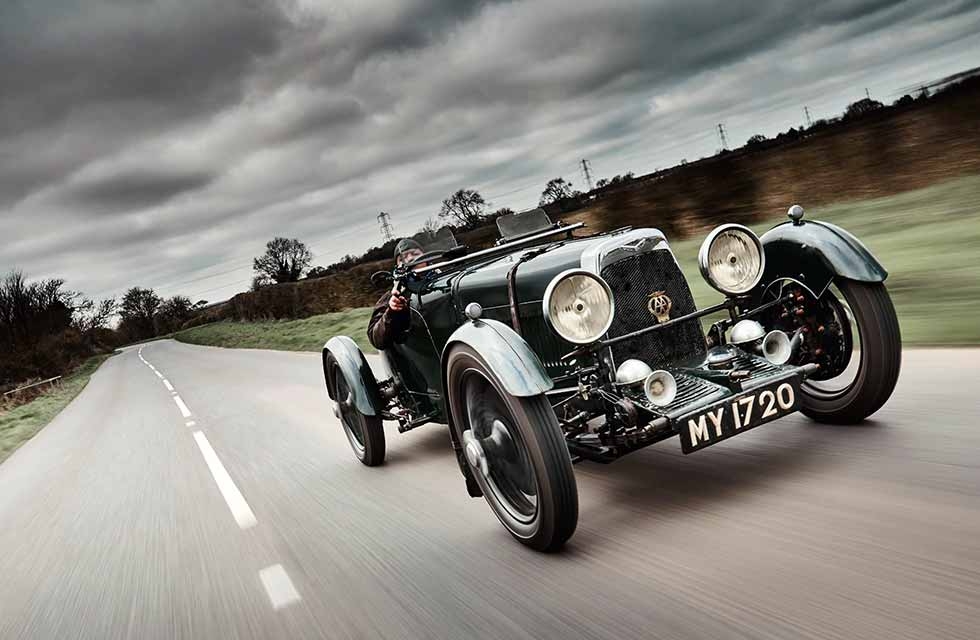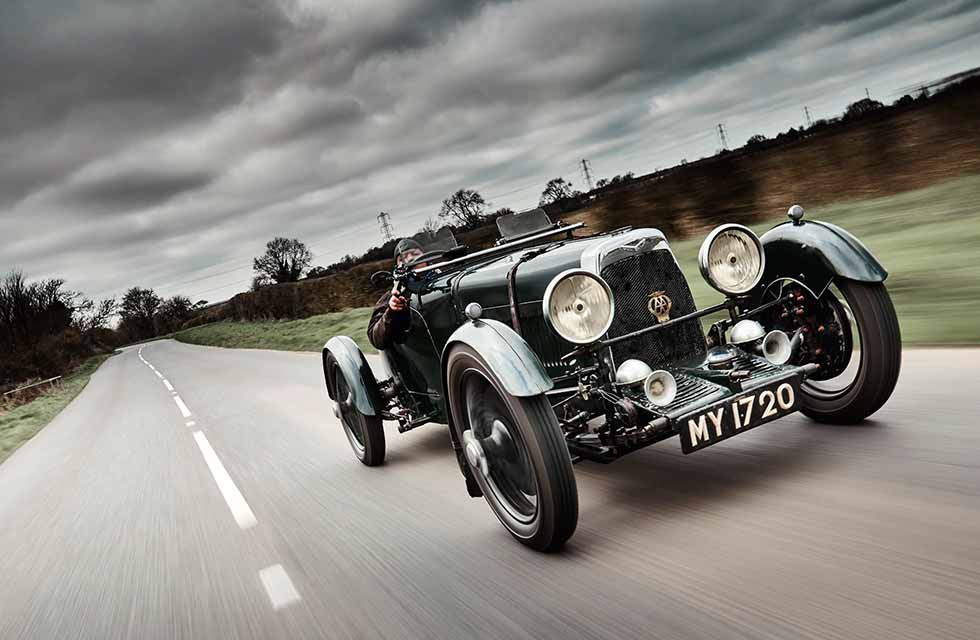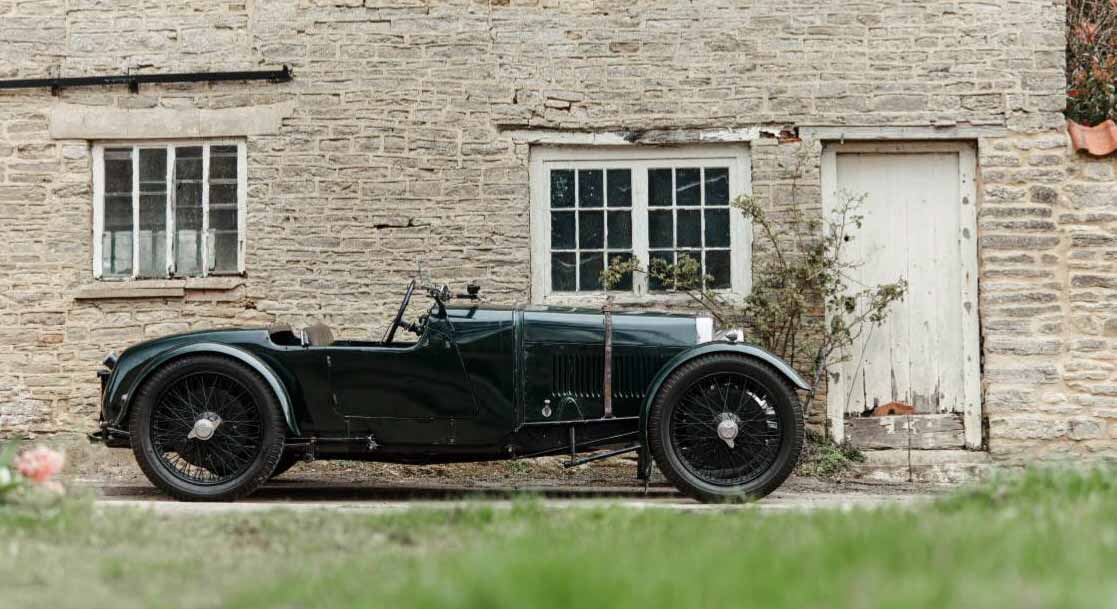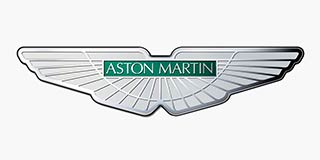
Only a handful of Sports Models – the basis for all the great pre-war Astons – were built. And none is more original than this. Words John Simister. Photography Aston Parrott.
Driving the oldest unrestored Aston in the world
THE FELTHAM FLYER 1928 ASTON MARTIN SPORTS
This car could very well be the oldest unrestored Aston Martin in the world, and one with the oldest running original cylinder block and head of the Bertelliera engine design. ‘Patina’ doesn’t begin to describe the look. Even the Rexine upholstery is original, with original splits.

But it’s no museum piece. It’s sitting outside Ecurie Bertelli of Olney, Buckinghamshire, the highest-profile specialist for pre-war Astons in modern times, idling away happily, vibrating from side to side on its vintage-looking Firestones. ‘It’s just over 90 years old,’ says Andy Bell, founder of Ecurie Bertelli and unable to keep away because, despite a vague intention to retire, he enjoys it too much. ‘And it handles beautifully.’
Aston Martin Sports Model chassis number S25 was built in 1928, so it’s a true vintage Aston. But not many vintage cars sit as racily low as this one. The lack of understanding on the part of the designers of the shape and size of the human form is more typical of the era, though, as I shall shortly discover. But, first: what exactly is MY 1720?
‘I’ll cruise along Sunset Boulevard and outclass all those yellow Lamborghini Murciélagos’
Designations for early Bertelli-era Aston Martins can be a bit fluid, as one model segues into its notional replacement, but the background goes something like this. Augustus Cesare Bertelli, aka ‘Bert’ (Italian born but Welsh bred) and William Renwick (Armstrong-Siddeley trained) acquired the bankrupt Aston Martin company in November 1926, as a vehicle through which they could build and sell their new high-class touring car.

This featured a new overhead-camshaft engine, generally credited to Bertelli but with Renwick’s patented wedge-shaped combustion chamber and with the detailed engineering drawn by Claude Hill, who would loom large in later Aston Martin history.
The new car was called T-type, but Bertelli considered it a bit staid. So, after 15 had been built, he decided that the company should make a few cars with a shorter, more agile chassis. Seven of these were built, two with three seats, and five – including this one – with two. The cars bore chassis numbers starting with S, which could stand for either ‘short’ or ‘sports’, but the catalogue’s official designation for these cars was Sports Model. This car is S25, and it’s a predecessor of the International models as well as the later, revised cars that were called LeMans from 1932.
Most, including S25, had a dry-sump engine, although Ecurie Bertelli currently has for sale an ex-India wet-sump version in yellow. S25 was for sale back in 2015, too, albeit reluctantly. Andy Bell really didn’t want to part with it but, says current owner Paul Lee, ‘I harried Andy and Robert [Blakemore, who now runs Ecurie Bertelli] for a long time until eventually they sold it to me.’ Paul lives in Los Angeles but has English connections, and the Sports Model is still here. Which is how I have come to be driving it.
‘I dragged it out of a shed in Poole five years ago, where it was part-hidden under a dinghy. It’d been there since 1972’
You can see why Andy Bell was – still is, actually – so attached to it. ‘I dragged it out of a wooden shed in Poole five years ago,’ he relates, ‘where it was part-hidden under a dinghy. An elderly man had read a story about a similar car that I owned, and told me about his. He’d bought it when he was at university in the early 1960s, and he used it until he moved on to a Frogeye Sprite. He drove the Aston into the shed in 1972 and it had stayed there ever since. I had to have it.’
That ‘elderly man’ was one George Bruce Styles, who bought the Aston Martin from Parade Motors of Broadstone. There had been six previous owners between May 1951, when the continuation logbook was issued, and Parade Motors’ acquisition of S25 on 2 August 1962, and doubtless a few more before then. HR Corbett was one, probably its original owner; he entered it in the Motor Cycling Club’s 1929 Land’s End Trial in which another Aston Martin was entered by racer SCH ‘Sammy’ Davis. A period photo shows a later custodian, who became a wartime RAF pilot, competing in a trial in the Midlands in 1938.
So original was S25 that Andy couldn’t countenance restoring it. It needed to be preserved as it was, its main departure from originality its hastily applied coat of dark green paint, sprayed on probably in the 1950s, flaking teasingly to reveal the original blue beneath and a piece of history in itself. Actually there were detail departures, too, such as smaller wheels and an amateurish dashboard in aluminium, but nothing that Ecurie Bertelli’s parts and expertise couldn’t discreetly remedy. However, Andy realised he had too many cars and this one had to go. Besides, Paul was being very insistent. ‘I sold it as I found it,’ says Andy, ‘and Paul commissioned us to do the repairs over the past year. He wanted us to do what was needed to make it usable and safe, but the brief was to make a daily driver that looked just as it did when found in the shed.’
That the engine block is original is a remarkable achievement because these engines were built with Duralumin connecting rods that had a tendency to break and smash a hole through the block. Ecurie Bertelli has supplied many new blocks over the years, and builds its engines with a new, stronger crankshaft and forged-steel connecting rods with modern shell bearings. As said, though, S25 retains its original block, albeit repaired early in its history where a broken rod or two had indeed seen daylight, and now properly welded and remachined. And, sensibly, the moving parts are new, their longevity protected by the addition of a 1930s Aston Martin oil-filter system. The rest of the car has been gone through, too. ‘What we’ve done,’ says Robert Blakemore, ‘is compress 40 years of servicing work into 14 months.’ Ecurie Bertelli has reinstated the correct wheels and has made a new wooden dashboard that looks, well, 91 years old. ‘We oiled the new wood to prevent paint taking to it properly,’ Robert explains, ‘then painted it. Then we distressed it.’
There’s other distressing sorcery, too, as Robert reveals. ‘We have rusted the new nuts and corroded the hose clips. There’s a compound you can get to do this. We’ve also aged the copper pipes. It’s the antithesis of polishing.’ No wonder the car caused a stir at the Salon Privé concours last year.
To wander around S25 is to be transported into a parallel world of things done differently, of time paused and restarted. We’ll start at the very front, with that numberplate and its yellowed, slightly cracked digits, which I reckon are from the early 1950s but might be older. What look like upper suspension links – unlikely, given the beam axle below – are actually ball-jointed Perrot shafts turned by rods to actuate the brakes. There are two giant horns, a brass AA badge and a radiator motif unique to the Sports Model.
The sharp-seamed ‘helmet’ wings, front and rear, hug the new but period-style Firestone 21-inch tyres within, lending a lean, racy aura. Under the bonnet we see a pair of brass-bodied, one-inch SU carburettors feeding straight into a shared plenum chamber – no gasflow optimisation here – and thence into the rectilinear engine. Behind it, the brackets that reinforce the aluminium bulkhead show signs of past welding repair. ‘They always break,’ says Robert, ‘and we had to replace one of them. We’ve reproduced a weld on that one, too.’
The petrol tank hides within the rounded, paint-blistered tail, but there’s a little space for luggage, provided you can get it past the battery and the back axle. This has worm drive, to keep the propeller shaft low in the chassis. Now it’s time for me to squeeze myself inside the cockpit, snagging my trouser-leg on a 1928 nail on the door sill, sliding my foot past a sliver of 1928 carpet and onto a floor covered with fragmented, possibly-1960s linoleum. The knife-shaped ignition advance lever, pointing downwards from the centre of the steering wheel, is aimed straight at my breakfast.
Were people really that small back then? The upright seat backrest, a single slab to bridge two occupants, brings me so close to the large steering wheel that my jacket is acting as a steering damper. My right elbow is outside the cabin because there’s nowhere else for it to go. My left foot, when not activating the clutch, is best hooked over the front of the gearbox out of the way if muscles are ever to relax. As for my right foot, it’s turned 45º anti-clockwise with the ankle tilted over before I can reliably operate the brake (on the right) and the throttle (in the centre). In the best road-test tradition, the gearlever, intriguingly topped with a tapered, rubber-cored knob possibly from a Morris Minor, falls readily to hand.
Facing page and above Aston in short-chassis form is nicely proportioned – from the outside – but low even by vintage standards; on the road it is surprsingly sprightly, with decent pace from its 56bhp 1500cc twin-carb ‘four’. This page, clockwise from top left All the right pedals, but not necessarily in the right order; a tight fit even for the fun-sized Simister; gearchange has a conventional shift pattern, thankfully; painted bulkhead; all-iron engine is fed by twin SUs; fuel tank is in the rear; rusty nuts may not be as old as they appear. Above It’s hard to credit this is a 90-year-old car from the way it corners and dives through bends. It is precise yet composed, thanks in no small part to the rear axle’s positive torque-tube location.
A giant Jaeger chromometric revcounter (non-functional) dominates the dashboard, although the oil-pressure gauge on the far right (functional) is little smaller. Switches include one to activate the magneto and another to switch on the fuel pump, both of which I trigger. My left toes find the starter button on the bulkhead and the engine chunters into life, keen and crisp on the throttle.
Clutch down, to the disturbing accompaniment of lightly grinding metal. ‘That’s normal,’ Andy assures me. ‘It’s a very basic clutch.’ If you open the bonnet with the engine running you can see it and the flywheel spinning out in the open, in the space between the crankcase and the separate gearbox, and you can see the pressure springs on the engine side of the flywheel, which are squeezed as the pegs within them are drawn back through the flywheel by the pressure plate’s rearward withdrawal. Yes, things really were done differently back then.
There’s no synchromesh, obviously. Nor are the gears even constantly in mesh; it’s all sliding pinions for the first three ratios and a dog-clutch for top. At least the gearchange gate is the normal way round, unlike the reversegate gearbox of Astons a few years younger.
After a respectful pause for gear wheels to stop spinning, I select first and bound away from Ecurie Bertelli’s forecourt.
Getting a silent gearshift is going to take some mental calibration on my part. It’s quite unforgiving even by crash-box standards, and the required double-declutching has to be very accurate. This is not easy when third gear is the noisiest third I’ve ever heard. Pre-war Aston Martin gearboxes always tend towards the cacophonous but this is something else, even in neutral. So divining engine revs mid-shift, with an on-strike tachometer, is a challenge. It’s a relief to be in top gear, able to hear the engine again As the learning curve levels off I start to score a reasonable hit-rate of slick-ish gearshifts. I even master the art of speedily flicking-up the reverse-gear guard when performing an about-turn for photographic purposes, then flicking it down again to ensure I find first rather than re-selecting retrogression, all before any traffic bears down on the Aston and me. The engine revs vigorously and pulls keenly, roaring with a mechanical zeal overlaid with the tidy thrash of tappets and chains. This car was rated at 56bhp when new, which feels credible today.
At least it does when the magneto isn’t overheating and ceasing to deliver sparks; a touch more fettling is needed on that front. Equally unexpected in the modernity of its motion is the way S25 steers, handles and holds the road. The structure feels very much all-of-a-piece by pre-war standards; it doesn’t shudder or chattermuch over bumps, although speed humps tax the suspension’s travel.
Through a series of bends it feels accurate, taut, level and grippy in a way hard to credit in a nonagenerian, helped in this precision by the postive torque-tube location of the rear axle. It must have been extraordinary in 1929.
Bertelli’s plan to make a sportier Aston turned out rather well, it seems. Even the rod brakes work with purposeful confidence. It’s enough to make me forget the ankle contortions completely, if not the constant need to remember where the accelerator pedal is. Paul Lee, of course, loves it. ‘It’s shockingly good to drive,’ he enthuses, ‘especially considering it’s the oldest Bertelli Aston engine out there. I’ve got a vintage Bentley too, which is like driving a steam train, but you’re right inside this one.
‘I took the Aston Martin for a drive across the Cotswolds with my mother, and I’ll be doing a run that Ecurie Bertelli organizes. Then I’ll ship it back home, cruise along Sunset Boulevard and outclass all those yellow Lamborghini Murciélagos.’
How, I ask Paul, do you register a car such as this for the road in the USA? ‘It’s actually easier to get a plate than it is in the UK. I can get MY 1720 on a California plate and run it on the UK plates. Then I can keep the California plate in the car so I can show the police that it has the right number if they stop me.’
He’s looking forward to confounding the concours buffs, too. ‘This car is so lived-in. Concours cars seem to be either super-restored or so original that no-one’s driven it for 60 years, but for me the most appealing cars are the ones that have been used for decades and have a bit of archaeology to them, like this car’s paint. There’s an engineer I know called Lagonda Joe, who won’t fix a pre-war car if it stays in the garage all the time. He says they have to be used.
‘It’s gloriously analogue, and the ergonomics word clearly hadn’t been invented in 1928. It’s so quick off the mark, too; I’m shocked that a car from 1928 can be so fast and corner so well. As for the gear-shifting, Andy Bell can do it all without double-declutching because he knows the cars so well and can time it all perfectly. I’m not quite at that level, but luckily they’re tough bits of machinery.’
Robert Blakemore tells me that today’s Aston Martin company is starting to take more interest in the pre-war cars, to learn about its roots and engage its customers with them, and Ecurie Bertelli will help in that process. Well, gurus of Gaydon, the concept of the truly sporting Aston Martin started right here.
THANKS TO Aston Martin specialist Ecurie Bertelli, www.ecuriebertelli.com.
1928 Aston Martin two-seater Sports Model
Engine 1495cc OHC four-cylinder, iron block and heads, two SU sidedraught carburettors
Max Power 56bhp @ 4250rpm
Max Torque 107lb ft @ 1900rpm
Transmission Four-speed manual, non-synchromesh, rear-wheel drive
Steering Worm and castor
Suspension Solid axles front and rear, leaf springs, Hartford friction dampers
Brakes Drums
Weight c900kg
Top speed c80mph






